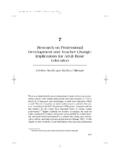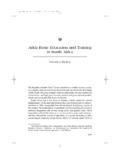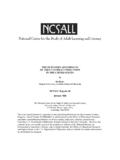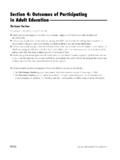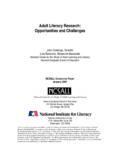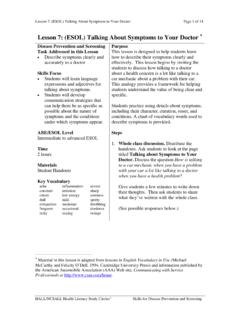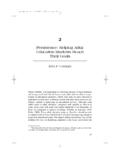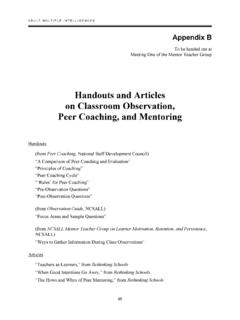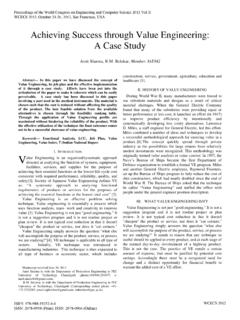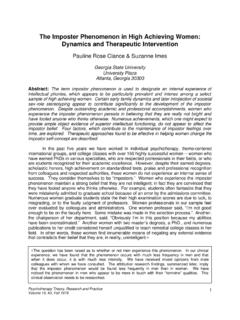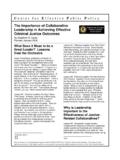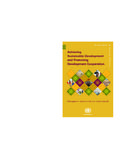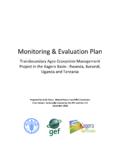Transcription of Achieving Adult Education Program Quality: A …
1 473 Achieving Adult EducationProgram quality : A Review ofSystematic approaches toProgram ImprovementMary Ziegler and Mary Beth Bingman The success of efforts to improve the quality of programs that provideadult Education has a direct impact on Adult students abilities to meettheir educational goals. Since 1991, policymakers in the United Stateshave taken two approaches to improving Program quality : focusing on theelements of a quality Program that lead to anticipated student outcomes orfocusing on student outcomes as the measure of a Program s quality . Taking the first approach, the National Literacy Act of 1991 mandatedthe development of Program quality indicators (PQI); the majority ofwhich focused on Program processes as a way to evaluate the effective-ness of Adult Education programs . PQI defined the processes that shouldbe in place at the Program level. For example, Indicator 7 states, Programsuccessfully recruits the population in the community identified in theAdult Education Act as needing literacy services (Office of Vocationaland Adult Education , 1992, p.)
2 14). PQI did not provide a systematic andconsistent way to either measure the process or the result of the 2/2/2007 6:54 PM Page 47at the state or national level, making it impossible to track improvementacross states. The Workforce Investment Act of 1998, on the other hand,mandated a systematic way of measuring results through a comprehensiveperformance accountability system. The National Reporting System (NRS)requires states to set performance levels and collect information on partic-ular student outcomes, but does not suggest a specific approach toimprove the quality of educational services that lead to these two approaches are not mutually exclusive, and most states andadult Education programs apply elements of both without necessarilyestablishing a link between the two. For either approach to be successful in improving Program quality , pos-itive change must occur at the Program level. To bring about change, statesand programs , including teachers and students, must engage in a processof examination of their data about student outcomes, Program processes,or both and then identify and implement plans for change based on thesedata.
3 This change process may happen haphazardly when individualteachers or directors make changes as they see fit. For example, a teachermight notice that a particular instructional approach does not seem to beworking and therefore abandon it, or a Program director might experimentwith giving fast-food coupons in an effort to improve attendance. Atthe other end of a continuum, Program improvement may be carried outsystematically in an effort that includes (a) explicit statement of goals,(b) systematic data collection that shows whether these goals are beingachieved, (c) identification and implementation of changes needed to bet-ter meet goals (including professional development and other necessarysupports for change), and (d) evaluation of results of the Program improvement occurs at the local Program level, stateadult Education agencies often guide these systematic efforts when multi-ple programs are involved.
4 In this chapter, we examine efforts of adulteducation agencies to work with local programs statewide to systemati-cally improve Program emphasis on Program quality and accountability mandated by the1991 and 1998 legislation for Adult Education programs is part of a largerfocus on quality and accountability in the private sector and this chapter, we begin by situating Adult Education programs in thislarger arena and reviewing the national efforts to improve Program qual-ity in Adult Education . We then review approaches that states are taking tosystematically improve Program quality and performance and examinemore closely case studies of three states. Finally, we draw conclusions48 ZIEGLER AND 2/2/2007 6:54 PM Page 48from state approaches and consider implications for practice, policy, AND ACCOUNTABILITY EFFORTSI nterest in Adult Education Program improvement parallels the private-sector quality movement.
5 quality emerged as a foundational concept inthe 1980s when the superiority of Japan s products threatened mar-kets. Since then,qualityhas become the term generally used to encom-pass the multiple outcomes, effects, and processes that organizationsmust pursue in order to achieve success (Winn & Cameron, 1998, p. 492).W. Edwards Deming contributed perspectives that increased the scopeof quality from a focus on manufacturing processes to the present-dayfocus on the management of an organization as a complex system(Walton, 1986). quality management emphasizes continuous improve-ment through organization-wide participation, customer satisfaction,management based on fact (or measurement), continuous improvement ,and SectorQuality as an overall management strategy proliferated in the UnitedStates as manufacturers addressed increasing competition from Japan andthe need to produce higher quality products more efficiently.
6 Improvingthe quality of products drew national attention in 1987 with the pas-sage of the Malcolm Baldrige National quality improvement Act and theestablishment of a national quality award for companies in the privatesector. The Act, administered by the Department of Commerce,mandated the development of a common framework on which to basejudgments about quality processes and outcomes. According to Winn andCameron (1998), the framework, referred to as the Baldrige Frameworkfor Excellence, integrated the majority of philosophies and techniquesespoused by quality theorists in North America and Asia. They point outthat quality , in the scholarly literature on organizations, is the term usedmost often to encompass the multiple outcomes, effects, and processesthat organizations pursue to achieve their goals. With the inception of theBaldrige Award Program in the private sector, quality concepts had gainedmomentum in government.
7 Adult Education Program 2/2/2007 6:54 PM Page 49 GovernmentIn government, rising costs, decreased quality of services, andentrenched bureaucracies created fertile ground for the need to adoptquality concepts. Building on the work of Deming, Osborne and Gaebler(1992) presented what they termed a new paradigm for reinventinggovernment. They argued that bureaucracy, appropriate in theindustrial era, was no longer effective for the postindustrial informationage. By focusing on compliance with regulations, government had lostsight of the results, which made management of public monies authors proposed that government must become entrepreneurial tomeet citizen demands to increase quality , lower costs, and improve effi-ciency. Osborne and Gaebler s book appeared at the same time theClinton administration began the National Performance Review (1993)(later named National Partnership for Reinventing Government) spear-headed by Vice President Albert Gore.
8 The Clinton administration initia-tive convened an interagency task force of federal employees to focus onways to make the government work better and cost less (Peckenpaugh,2001).The following year, Congress passed the Government Performance andResults Act of 1993 (GPRA) to reduce waste and inefficiency in federalprograms. quality concepts are embedded in the legislation s language;for example, Section 2, Findings and Purposes, lists the following threepurposes (we have added explanatory comments in brackets): Promote a new focus on results, service quality , and customer sat-isfaction [this gave rise to the use of the word customerinstead ofclientin many social-service agencies]. Help federal managers improve service delivery by .. providingthem with information about Program results and service quality [this describes the feedback loop proposed by Deming]. Improve Congressional decision making by providing more objectiveinformation [an example of management by fact or measurement].
9 The GPRA legislation also called for strategic planning, performancetargets, and measurement of performance over time. Management byfact introduced objectivity into decision making and led to a plethoraof measurement initiatives to help agencies define which results shouldbe measured and develop ways to measure them (GPRA, 1993). The lan-guage of quality particularly the focus on meeting the needs of the50 ZIEGLER AND 2/2/2007 6:54 PM Page 50customer, use of data and measurement for decision making, and continuousimprovement then spilled into Education at all levels. EducationOver the last decade, educational agencies have faced increasing criticismfor the failure of schools. The purpose of the Goals 2000: EducateAmerica Act, which became law in 1994, was to improve the quality ofeducation for all students by improving student learning through a long-term, broad-based effort to promote coherent and coordinated improve-ments in the system of Education throughout the Nation at the State andlocal levels (Goals 2000: Educate America Act, 1994).
10 Arif and Smiley(2003) examined the history of accountability in Education and the stepsthat ultimately led to the demand to improve quality . They reviewed aseries of federal reports from the early 1980s that were sharply critical ofeducation, beginning with the maelstrom generated by A Nation at Risk:The Imperative for Educational Reform(National Commission onExcellence in Education , 1983),which proclaimed that falling educationalachievement was endangering the strength of the United States incommerce, technology, and science. Other reports, such as AcademicPreparation for College: What Students Need to Know and Be Able to Do(The College Board, 1983) andAmerica s Competitive Challenge: TheNeed for a National Response(American Council on Education ,Business-Higher Education Forum, 1983) emphasized the need forimproving the quality of Education . Arif and Smiley (2003) traced the linkbetween public policy, the application of total quality management in edu-cation beginning in the 1980s, and its expansion over the years into theBaldrige Award.
